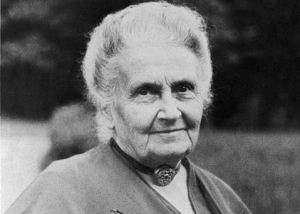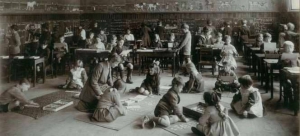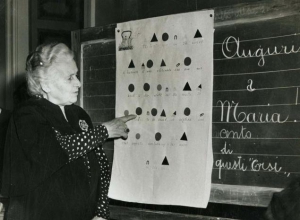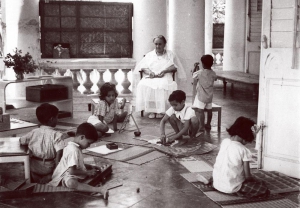Who is Maria Montessori?
Dr. Maria Montessori was one of the most influential pioneers in early childhood education in the 20th century. Montessori’s ideas have become known and recognized in many countries over a period of more than ninety years and yet still seems to educate students in a fresh, modern and child-centered way that allows them to be extremely successful in many ways. It is no surprise that her ideas have also been incorporated into good practice in mainstream education.
Dr. Montessori was born in Italy in 1870. Her original interest was in medicine; she was the first woman to graduate from the University of Rome Medical School and gradually became interested in education through her work as a doctor, treating children with what are known today as ‘special needs’. Because of her medical background she approached education not as an educator or a philosopher but as a scientist, studying and observing how students learn. She made the needed adjustments to the teacher and classroom to best serve each student effectively which is the model we still use today!
Dr Montessori worked with some of the poorest, highly challenged and most disadvantaged children of working parents in Rome. She used the classroom as a laboratory for developing ideas and materials which would serve future students and help them to achieve their full potential. There was nothing cold or clinical about her theories: they were tailored to the needs of the growing child but sprang from Montessori’s intense love and respect for all children. So great was the success of her Montessori Method that she traveled the world, establishing schools and lecturing about her discoveries. She wrote numerous books and many articles right up until her death in 1952 at the age of 82.
She left to the world the legacy of a method of education which combines a practical approach based on a carefully planned learning environment with a philosophy centered on the idea of freedom for the child. All children, says Montessori, are intrinsically motivated to learn and they absorb knowledge without effort when provided with the right kind of activities at the right time in their development.




Developing the Child
Montessori saw that children held within them something wonderful and special that it could be the key to changing the world. She saw that they were inherently good and that, if allowed to develop freely, they felt connected to everything and were naturally caring to each other and the world around them. The more that she worked with the children, the more convinced she was that they had precise inner guides and that the work of adults was to help them to be all that they could be. She felt that it was the spiritual nature of children that had been forgotten and denied and that children could therefore show adults the way to return to a more meaningful, holistic way of living.
Dr. Maria Montessori’s approach to education was to observe children carefully to discover their individual needs. She was a great innovator, always aware that education needs to change as society changes.
She believed that teachers could be trained to make children confident and capable self educators prepared and equipped for the future.
The Montessori approach places emphasis on educating the whole child, covering all aspects of development – intellectual, social, physical, emotional and spiritual. Building upon children’s intrinsic desire to learn, Montessori created ideal environments full of opportunities for children to experiment and initiate their own education.
At the heart of the method are the Montessori materials, beautiful and enticing pieces of equipment which have been
carefully designed to incorporate a teaching purpose. Understanding, dexterity and skill are developed each time the child uses them.
“I do not believe there is a method better than Montessori for making children sensitive to the beauties of the world and awakening their curiosity regarding the secrets of life.”
~Gabriel Garcia Marquez (Colombian Novelist and Nobel Prize in Literature)
Common Questions about Montessori
How many students are typically in a Montessori class?
Unlike some private schools, which strive for very small classes, Montessori values the lessons of community when the size of the class is somewhat larger.
Montessori classes for children above the infant & toddler level might include 20–30 students whose ages span 3 years. All members of the community benefit from this set-up. Older students are proud to act as role models; younger ones feel supported and gain confidence about the challenges ahead. Classes for infants & toddlers are smaller, with typically 10–15 children.
How can children learn if they’re free to do whatever they want?
Dr. Montessori observed that children are more motivated to learn when working on something of their own choosing. A Montessori student may choose his focus of learning on any given day, but his decision is limited by the materials and activities—in each area of the curriculum—that his teacher has prepared and presented to him.
Beginning at the elementary level, students typically set learning goals and create personal work plans under their teacher’s guidance.
Why are Montessori schools all work and no play?
Dr. Montessori realized that children’s play is their work—their effort to master their own bodies and environment—and out of respect she used the term “work” to describe all their classroom activities. Montessori students work hard, but they don’t experience it as drudgery; rather, it’s an expression of their natural curiosity and desire to learn.
If children work at their own pace, don’t they fall behind?
Although students are free to work at their own pace, they’re not going it alone. The Montessori teacher closely observes each child and provides materials and activities that advance his learning by building on skills and knowledge already gained. This gentle guidance helps him master the challenge at hand—and protects him from moving on before he’s ready, which is what actually causes children to “fall behind.”
Do Montessori teachers follow a curriculum?
Montessori schools teach the same basic skills as traditional schools, and offer a rigorous academic program. Most of the subject areas are familiar—such as math, science, history, geography, and language—but they are presented through an integrated approach that brings separate strands of the curriculum together.
While studying a map of Africa, for example, students may explore the art, history, and inventions of several African nations. This may lead them to examine ancient Egypt, including hieroglyphs and their place in the history of writing. The study of the pyramids, of course, is a natural bridge to geometry.
This approach to curriculum shows the interrelatedness of all things. It also allows students to become thoroughly immersed in a topic—and to give their curiosity full rein.
Can Montessori accommodate gifted children? What about children with other special learning needs?
An advantage of the Montessori approach—including multi-age classrooms with students of varying abilities and interests—is that it allows each child to work at her own pace. Students whose strengths and interests propel them to higher levels of learning can find intellectual challenge without being separated from their peers. The same is true for students who may need extra guidance and support: each can progress through the curriculum at his own comfortable pace, without feeling pressure to “catch up.”
We might note that from a Montessori perspective, every child is considered gifted, each in her own way. For every child has his own unique strengths—it is all a matter of degree.
Source: American Montessori Society
